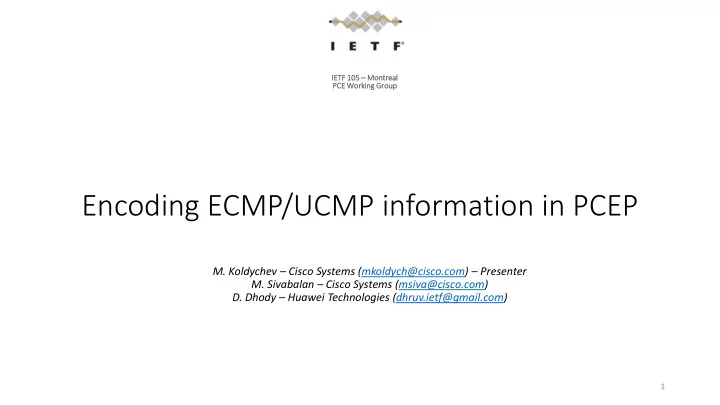

IET ETF 105 – Mo Montreal PCE PCE Wor Working Gro roup Encoding ECMP/UCMP information in PCEP M. Koldychev – Cisco Systems (mkoldych@cisco.com) – Presenter M. Sivabalan – Cisco Systems (msiva@cisco.com) D. Dhody – Huawei Technologies (dhruv.ietf@gmail.com) 1
Encoding ECMP/UCMP in information in in PCEP We are motivated by the need to encode multiple Segment Lists in SR- TE Policies, but our results are meant to be generic. Terminology: • ERO == Explicit Route Object • LSP == PCEP LSP (identified by LSP-IDENTIFIERS) 2
Motivation In SR-TE Policy, the optimization problem is defined by optimization objectives and constraints and the solution to the optimization problem is a set of Segment Lists. https://tools.ietf.org/html/draft-ietf-spring-segment-routing-policy-03 A dynamic candidate path expresses an optimization objective and a set of constraints. The headend (potentially with the help of a PCE) computes the solution Segment-List (or set of Segment-Lists) that solves the optimization problem. If a candidate path is associated with a set of Segment-Lists, each Segment-List is associated with a weight for weighted load balancing (refer Section 2.11 for details). The default weight is 1. 3
Motivation (cont’d) Two use-cases: 1. One optimization objective yields multiple ECMP paths. 2. Multiple optimization objectives sharing ECMP. These two use-cases are orthogonal, they exist independently of each other. For example: • LSP 1 and LSP 2 have different optimization objectives and ECMP is desired • LSP 1 gets a single path X • LSP 2 gets two ECMP paths: Y and Z • As a result 50% of traffic goes on path X, 25% on path Y and 25% on path Z. 4
Use Case 1 Use Case 1: single optimization objective yields multiple paths. • Extend PCEP to specify the maximum number of ECMP paths that the PCC can handle • Extend PCEP to allow for multiple ERO objects within a single LSP, some options are possible: A. define a new object to “separate” the EROs and carry per -ERO attributes B. follow RFC 8623 for encoding multiple EROs C. other proposals (to be discussed on mailing list) 5
Analysis of Option A We can replace a single ERO object by multiple ERO objects, separated by a new ERO-ATTRIBUTES object. Current BNF: <intended-path> = <ERO> Proposed BNF: <intended-path> = <ero-list> <ero-list> = [<ERO-ATTRIBUTES>]<ERO>[<ero-list>] 6
Analysis of Option A (cont’d) Define ERO-ATTRIBUTES object to carry some per-ERO attributes: 0 1 2 3 0 1 2 3 4 5 6 7 8 9 0 1 2 3 4 5 6 7 8 9 0 1 2 3 4 5 6 7 8 9 0 1 +-+-+-+-+-+-+-+-+-+-+-+-+-+-+-+-+-+-+-+-+-+-+-+-+-+-+-+-+-+-+-+-+ | Flags | Oper| +-+-+-+-+-+-+-+-+-+-+-+-+-+-+-+-+-+-+-+-+-+-+-+-+-+-+-+-+-+-+-+-+ | Weight | +-+-+-+-+-+-+-+-+-+-+-+-+-+-+-+-+-+-+-+-+-+-+-+-+-+-+-+-+-+-+-+-+ ~ Optional TLVs ~ +-+-+-+-+-+-+-+-+-+-+-+-+-+-+-+-+-+-+-+-+-+-+-+-+-+-+-+-+-+-+-+-+ Support for ERO-ATTRIBUTES can be negotiated in the OPEN message, thus guaranteeing backward compatibility. 7
Analysis of Option B https://tools.ietf.org/html/rfc8623 - Stateful Path Computation Element (PCE) Protocol Extensions for Usage with Point-to-Multipoint TE Label Switched Paths (LSPs) RFC 8623 already defines a way to carry multiple ERO/RRO objects, by using a special type of END-POINTS object and an S2LS object. We can define a new END-POINTS and S2LS object types for P2P load-balancing and then we can follow the same encoding format as RFC 8623. 8
Analysis of Option B (cont’d) S2LS format is almost the same as ERO- ATTRIBUTES, except that it’s missing the Weight field: 0 1 2 3 0 1 2 3 4 5 6 7 8 9 0 1 2 3 4 5 6 7 8 9 0 1 2 3 4 5 6 7 8 9 0 1 +-+-+-+-+-+-+-+-+-+-+-+-+-+-+-+-+-+-+-+-+-+-+-+-+-+-+-+-+-+-+-+-+ | Flags | Oper| +-+-+-+-+-+-+-+-+-+-+-+-+-+-+-+-+-+-+-+-+-+-+-+-+-+-+-+-+-+-+-+-+ ~ Optional TLVs ~ +-+-+-+-+-+-+-+-+-+-+-+-+-+-+-+-+-+-+-+-+-+-+-+-+-+-+-+-+-+-+-+-+ The weight can be either carried in an optional TLV, or it can be embedded directly as part of the new S2LS object type. New END-POINTS object type would need to be defined, to specify that the S2LS objects that follow it are for ECMP/UCMP. 9
Analysis of Option B (cont’d) For example, suppose the PCE was computing a path from Source A to Destination X and the result was 2 EROs: {A,B,X} and {A,C,X}. Suppose that the 2 EROs have UCMP weights 2 and 3 respectively. Then the PCE would encode this as follows: Common Header LSP END-POINTS (SRC=A, DEST=X) S2LS (O=UP, WEIGHT=2) ERO1={A,B,X} END-POINTS (SRC=A, DEST=X) S2LS (O=UP, WEIGHT=3) ERO2={A,C,X} Note that we need to encode 2 END-POINTS objects here if we want to encode 2 S2LS objects, in order to conform to the RBNF of RFC 8623. If both EROs had the same weight (ECMP), then we would not need 2 S2LS objects and we would encode ERO2 directly after ERO1. 10
Use Case 2 Use Case 2: multiple optimization objectives sharing ECMP. • Allocate a different PCEP Tunnel for every objective. • Create a new PCEP association type (Ex., “ECMP Association”) to bind these Tunnels together. 11
Combination of both Use Cases Going back to our previous example: • LSP 1 and LSP 2 have different optimization objectives and ECMP is desired • LSP 1 gets a single path X • LSP 2 gets two ECMP paths: Y and Z • As a result 50% of traffic goes on path X, 25% on path Y and 25% on path Z. PCEP representation of the above: • ECMP ASSOCIATION contains LSP 1 and LSP 2. • LSP 1 contains a single ERO: X. • LSP 2 contains two EROs: Y and X. 12
Recommend
More recommend